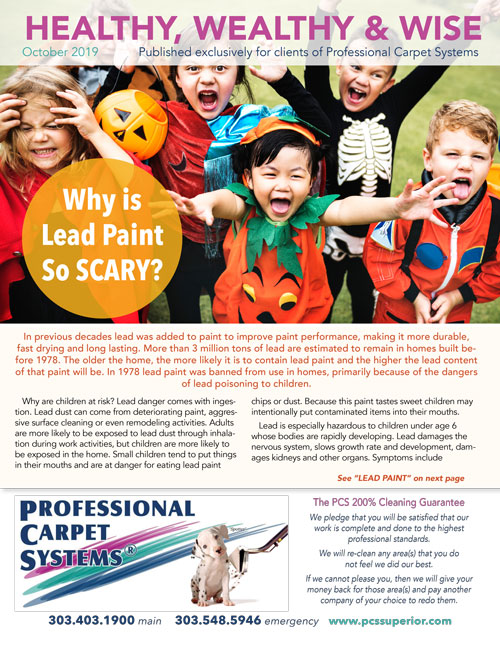Here’s our client newsletter for October 2019.
 Click to see the full newsletter
Click to see the full newsletter
Why is Lead Pain So SCARY?
In previous decades lead was added to paint to improve paint performance, making it more durable, fast drying and long lasting. More than 3 million tons of lead are estimated to remain in homes built before 1978. The older the home, the more likely it is to contain lead paint and the higher the lead content of that paint will be. In 1978 lead paint was banned from use in homes, primarily because of the dangers of lead poisoning to children.
Why are children at risk? Lead danger comes with ingestion. Lead dust can come from deteriorating paint, aggressive surface cleaning or even remodeling activities. Adults are more likely to be exposed to lead dust through inhalation during work activities, but children are more likely to be exposed in the home. Small children tend to put things in their mouths and are at danger for eating lead paint chips or dust. Because this paint tastes sweet children may intentionally put contaminated items into their mouths.
Lead is especially hazardous to children under age 6 whose bodies are rapidly developing. Lead damages the nervous system, slows growth rate and development, damages kidneys and other organs. Symptoms include behavioral problems, such as irritability and shortened attention span, hyperactivity, suppression of appetite, sleep disturbance, hearing impairment, short-term memory loss, and reductions in intelligence. In adults, exposure to lead can cause reproductive problems, high blood pressure, depression and other mood disorders. Exposure to high levels can lead to nausea, flu-like symptoms, body aches, extreme fatigue and in severe cases, coma and even death.
If your home has painted surfaces or furnishings that were painted before 1978 you could have lead. Don’t panic. Your best course of action is to buy test kits in home stores or hire a certified lead paint inspector to test your home.
If you have lead paint, or suspect it, take these steps to reduce your exposure to lead:
Have the items replaced, minimizing dust by using dust control measures, thorough cleaning and proper disposal. Check local regulations to assure compliance. Items that are difficult to remove should be replaced by professionals who will control and contain lead contaminated dust. These companies are trained and certified in Lead Safe Work Practices and will have a certificate to prove it.
Cover the lead-based paint. There are specialized sealants that you can use to encapsulate and control a deteriorating surface. However this is a temporary solution. Eventually the new coating will begin to deteriorate and you could end up right back where you started from.
Remove the contaminated paint. Hire a professional lead paint abatement contractor. It is important that the company you hire be certified to remove lead. Check their credentials and get referrals from people they have worked for recently. Improperly done, lead paint removal can create a great deal of lead-contaminated dust, chips and debris, leaving your home more contaminated than before.
Periodically wet mop and wipe lead contaminated surfaces such as window sills, trim, walls and floors with household cleaning detergent solution or a specialty cleaner designed for lead dust. This is a preventive, ongoing maintenance measure and is not an alternative to replacement or removal.
Be careful when doing any kind of remodeling, painting or renovation. If you suspect lead paint, make sure the professional you hire is certified by the EPA in Lead Safe Work Practices.
Any carpeting and upholstery exposed to lead dust should be professionally cleaned to remove dust and contamination, especially after a renovation or remodeling.
Call Professional Carpet Systems to learn more about how we can help.
